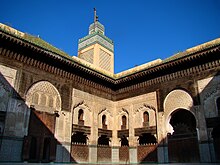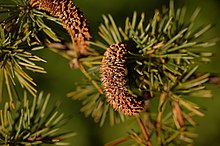Atlas cedar
| Atlas cedar | ||||||||||||
|---|---|---|---|---|---|---|---|---|---|---|---|---|

Blue Atlas Cedar ( Cedrus atlantica cv. 'Glauca') |
||||||||||||
| Systematics | ||||||||||||
|
||||||||||||
| Scientific name | ||||||||||||
| Cedrus atlantica | ||||||||||||
| ( Endl. ) Manetti |
The Atlas cedar ( Cedrus atlantica ) is a plant from the genus of cedar ( Cedrus ) in the family of Pinaceae (Pinaceae). It was added to the Red List of Endangered Plant Species in 2013 .
Occurrence
The home of the Atlas cedar is the North African Atlas and Rif Mountains , with no known occurrence in the arid Anti-Atlas Mountains . At altitudes between 1000 and 1800 meters it forms pure stands or is associated with the Numidian fir or various types of pine . It has been planted as an ornamental tree in the mild climate of southern Europe since the middle of the 19th century ; since the late 20th century, Atlas cedars have also been used for forestry, especially in the French Luberon and Corsica . The Atlas cedar also thrives in the protected areas of Central Europe ( Lake Constance , Rhineland , Rügen ). The atlas cedar is also planted in a blue form ( Cedrus atlantica 'Glauca'), which is considered to be somewhat hardier, in climatically less favorable locations.
description
Habit and bark
The Atlas cedar is an evergreen tree that reaches heights of 40 meters and a trunk diameter of 200 centimeters. The growth of Atlas cedars is often very individual, both in the pure species and in the garden forms, so that a determination based on the appearance - especially with older cedars - is very difficult. Atlas cedars can live up to 900 years. In the youth, loosely conical with an upright peak. In old age the crown is irregular, often with multiple stems. Branches irregular and growing steeply upwards. The bark of young trees is gray and smooth, in older Atlas cedar trunks it is scaly, somewhat cracked and dark to blackish gray. The bark of the non-hanging branches is densely hairy and yellowish.
Needles
The needles of the Atlas cedar are 1.5 to 2.5 cm long, 1 to 1.2 mm wide on short shoots 10 to 30 tufted, growing sporadically on long shoots , stiff and pointed, bluish-green, about the same length.
Cones and seeds
The Atlas cedar is single-sexed ( monoecious ). The flowering capacity of the Atlas cedar begins with 25 to 30 years. The cones grow upright on short shoots. Male cones are pale yellow, cylindrical, 3 to 5 cm long. Female cones are inconspicuous, green to reddish, 1 cm long, egg-shaped. The seed scales are about 3.5 cm wide.
When ripe, the cones have a length of 5 to 7.5 cm and a diameter of up to 4 cm; they are barrel-shaped, with a flat or indented tip. In the first year they are light green, in the second light brown, upright. After ripening (ripening time 2 to 3 years) the cones disintegrate on the tree, whereby the woody spindle remains.
The seeds are 1 to 1.2 cm long, with 1.2 to 1.5 cm long wings; they germinate easily.
Taxonomy
The Atlas cedar ( Cedrus atlantica (Endl.) Manetti ex Carrière ) has the following synonyms: Pinus atlantica Endl. , Abies atlantica (Endl.) Lindl. & Gordon , Pinus cedrus var. Atlantica (Endl.) Parl. , Cedrus libani subsp. atlantica (Endl.) Batt. & Trot. , Cedrus africana Gordon ex Knight , Cedrus libanotica subsp. atlantica (Endl.) Jahand. & Maire .

use
- Wood
The wood of the Atlas cedar was probably already used in Phoenician - Roman antiquity. In the Middle Ages, beams were made from the trunk wood for the ceilings and doors of sacred and representative buildings ( mosques , madrasas , mausoleums and palaces); the wooden decorative panels of the Merinid madrasas are also carved from the wood of the Atlas cedar. Some of the approx. 800 year old woods are still original, others have been replaced.
- oil
Cedarwood or cedar oil exudes a pleasantly tart scent that is not unlike that of sandalwood. Cedar oil was probably already popular in ancient times and is now highly valued by perfume manufacturers all over the world.
Web links
- Atlas cedar on www.baumkunde.de.
- Cedrus atlantica - Photos and information (English)
- Thomas Meyer: Data sheet with identification key and photos at Flora-de: Flora von Deutschland (old name of the website: Flowers in Swabia )
Individual evidence
- ↑ Cedrus atlantica - Entry in the Red List of Endangered Plant Species (English)
- ↑ Rafaël Govaerts (ed.): Cedrus atlantica. In: World Checklist of Selected Plant Families (WCSP) - The Board of Trustees of the Royal Botanic Gardens, Kew . Retrieved April 10, 2019.
- ↑ Cedar oil and perfumes - photos + information



